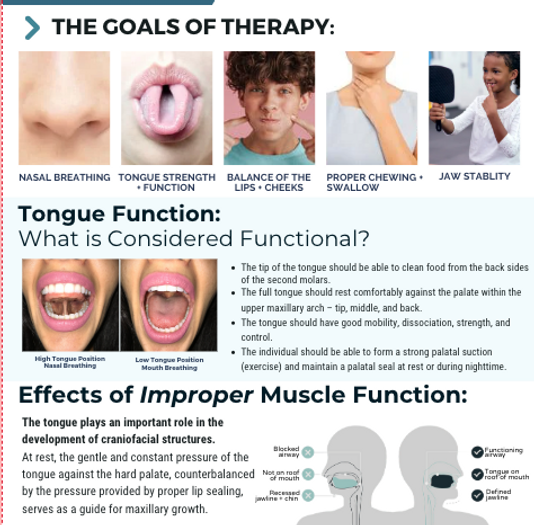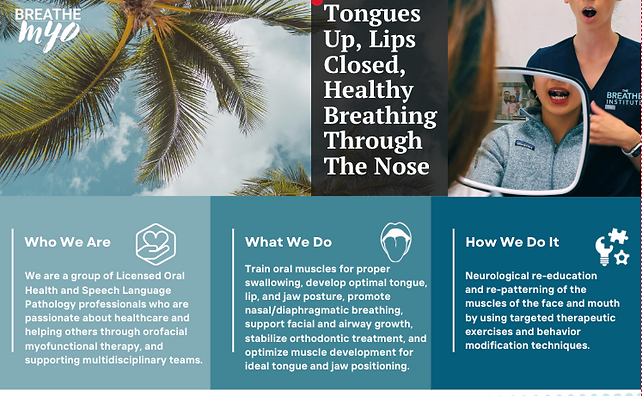Myofunctional Therapy

WORKING WITH THE MUSCLES OF THE LIPS, TONGUE, CHEEKS. AND FACE







Highly Effective Physical Therapy Exercises to Improve Breathing, Bite, and Orofacial Posture
Myofunctional therapy is a program used to correct the improper function of the tongue and facial muscles. It involves strengthening of the tongue and orofacial muscles by teaching individuals how to engage the muscles to the appropriate position.
Individuals with predominant mouth breathing (or insufficient habitual nasal breathing) often develop maladaptive habits and patterns of orofacial function that may impact various conditions including:
-
Facial skeletal growth (maxillofacial development)
-
Sleep-disordered breathing (including snoring and sleep apnea)
-
Nasal obstruction
-
Oral hygiene and dental problems
-
Teeth grinding (bruxism)
-
Temporomandibular joint dysfunction
-
Neck and shoulder tension
-
Speech problems
-
Facial esthetics
-
And more....
Proper diagnosis allows for targeted and effective physical therapy exercises for oral posture retraining to promote better health with goals to improve breathing, reduce pain, and enhance quality of life. Please refer to Academy of Orofacial Myofunctional Therapy for a more detailed explanation on the impact of maladapative orofacial posturing on maxillofacial growth and development: https://aomtinfo.org/myofunctional-therapy.
Research
Recent research has shown that myofunctional therapy may reduce the symptoms of sleep disordered breathing (such as snoring), and ameliorate mild to moderate OSA (obstructive sleep apnea). It has also been shown to prevent relapse of sleep apnea after surgical treatment. In addition, myofunctional therapy exercises play a critically important role in recovery after lingual frenuloplasty and to maintain the results of orthodontic treatment.


Video: UCLA Research Presentation. Lingual frenuloplasty with myofunctional therapy for the treatment of mouth breathing, snoring, clenching, and myofascial tension in appropriately selected patient candidates.
Video: Experts discuss research on myofunctional therapy to treat obstructive sleep apnea.
Sample Exercises
The following exercises are provided as an introduction and general overview for educational purposes only. We highly recommend that myofunctional therapy exercises be performed under the supervision of a certified and experienced myofunctional, occupational, or speech therapist for proper results. Please note that different sets of exercises are often recommended to each patient depending on the specific anatomic profile and orofacial dysfunction of each individual. The exercises prescribed are often modified and individually-tailored as appropriate according to a step-by-step treatment plan under the guidance of an experienced therapist.
Please contact us at appts@zaghimd.com to be matched with a therapist in your area.
Resource #1: Sanda Valcu-Pinkerton, RDH, COM™ (Certified Orofacial Myologist)
www.MyofunctionalTherapyLA.com
The following exercises should be repeated 10 times and ideally the entire set should be done at least 4 times per day. In total, 45 minutes per day should be devoted to the therapy. The regimen includes:
Exercise 1: Push Up the Tongue - Place the tip of the tongue against the hard palate on the roof of the mouth, just behind the top teeth, and push upwards and hold for 5 seconds. Repeat 10 times.
Exercise 2: Touch Nose - Stick out your tongue and try to touch the tip of your nose and hold for 10 seconds, then relax. Repeat 10 times.
Exercise 3: Touch Chin - Stick out your tongue and try to lick the bottom of your chin and hold for 10 seconds, then relax. Repeat 10 times.
Exercise 4: Push Tongue Left - Stick out your tongue and move it as far as you can to the left and hold for 10 seconds, then relax. Repeat 10 times.
Exercise 5: Push Tongue Right - Stick out your tongue and move it as far as you can to the right and hold for 10 seconds, then relax. Repeat 10 times.
Exercise 6: Roll Tongue - Roll your tongue by folding the edges toward the middle lengthwise, so it looks like the end of a taco shell. Stick it out as far as you can while keeping it folded and hold for 10 seconds, then relax. Repeat 10 times.
Exercise 7: Click the Tongue - Make a loud clicking sound with the tongue against the roof of the mouth. Click the tongue for 15 seconds and then repeat 10 times.
Exercise 8: Push the Tongue Against a Spoon -Push the tip of your tongue firmly against a spoon held in front of your lips for 10 seconds. Keep the tongue straight and don't let it point downwards. Repeat 10 times.
Exercise 9: Hold a Spoon - Place the handle of a metal spoon between your lips and hold it in place with only your lips for 10 seconds. Do not place the handle between your teeth. Try to keep it parallel to the floor. As your strength improves, you can place other small objects on the spoon for added weight (i.e., sugar cube). Repeat 10 times.
Exercise 10: Hold a Button - For children and adults who are not at risk of swallowing a button, tie one to a piece of string at least 10 cm in length. Place the button between the teeth and lips. Purse your lips tightly and pull out on the string, not letting it to slip out. Pull for 10 seconds, then relax. Repeat 10 times. For added difficulty, place the button flat between the lips.
Resource #2: Stanford Sleep Medicine- Myofunctional Therapy Blogspot
Similar regimen that includes pictures and references for more detailed instructions.
Orofacial Muscle Re-Education. Posted by Dr. Christian Guilleminault based on Rééducation des fonctions dans la thérapeutique orthodontique, 1990 - Friday, June 15, 2012.
Myofunctional Therapy: Additional Exercises. Update posted by Dr. Christian Guilleminault of Stanford Sleep Disorders Clinic on Monday, August 3, 2015.
Resource #3: YouTube.com -- Dr. Audrey Yoon, DDS (Pediatric Dentist and Orthodontist)
Myofunctional Therapy with Dr. Audrey Yoon: Video Demonstrations.
Resource #4:
Video: Introduction to Orofacial Myofunctional Therapy
Explained by Joy L. Moeller,
Myofunctional Therapist and Instructor
Success Stories
Case Study: Leslie M.– 60 year-old female with snoring, teeth grinding, jaw pain, and dental malocclusion improving after only 3 weeks of myofunctional therapy. No longer needs her NTI device or orthotic.









